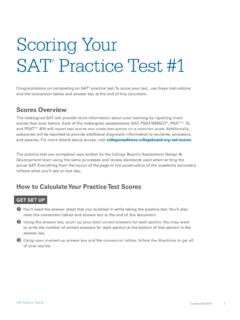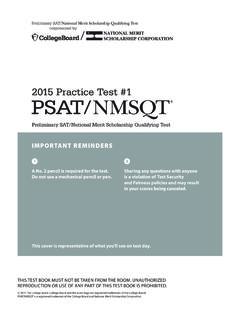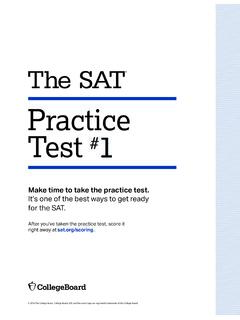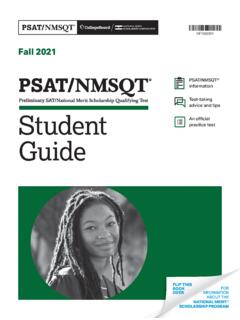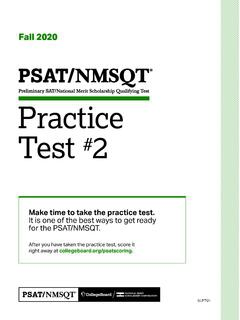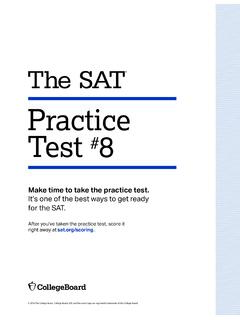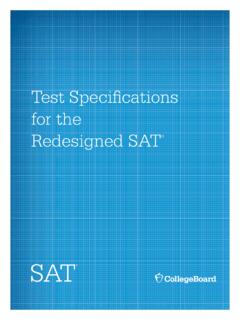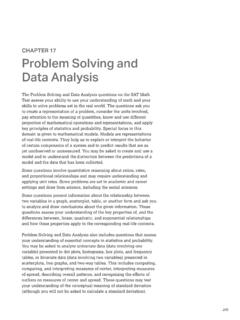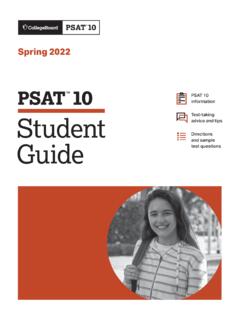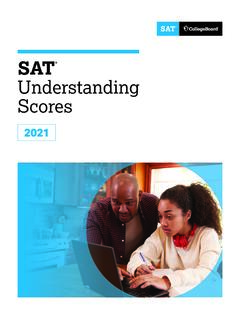Transcription of CHAPTER 1 Introducing the SAT - SAT Suite of Assessments
1 3 CHAPTER 1 Introducing the SATW elcome to the Official SAT study guide ! This guide is designed for you. Return to it again and again in the coming weeks and months. Reading it is an excellent way to become familiar with the SAT its content, structure, timing, question types, and more. The information, advice, and sample questions will help you prepare to take the test with new things makes most of us nervous, but when we can learn a great deal about a new situation in advance, we feel much more able to take a deep breath and meet the challenge. Learning about the SAT through this guide and taking practice tests will help you be well prepared when your test date the 2020 EditionThis study guide consists of eight practice tests , all written in the same process and by the same team of authors as the actual exam.
2 With each new edition of the study guide , older practice tests will be retired and new ones added, ensuring that you have the opportunity to practice on the latest selection of practice tests . The practice tests in this study guide number 1, 3, and 5 through 10, with Practice Test 10 presented 1 | Getting Ready for the SAT4 How Does the SAT Measure Academic Achievement?Questions on the SAT will not ask you to recall details of Hamlet or to name the capital of Nevada or the location of the Rappahannock River. If you recall those facts, good for you, but the SAT will ask for something different. Instead of asking you to show what you ve memorized, the questions invite you to exercise your thinking of the learning you ve done from childhood to now contributes to how you think, how your mind manages information.
3 Even if you don t recall the details of a history or science lesson, the process of learning information and blending it with previously learned information is key to becoming a skilled world needs more people who can use their thinking skills to solve problems, communicate clearly, and understand complex relationships. The best high school courses promote thinking skills, and colleges are looking for students who are skilled thinkers. The SAT is designed to measure the thinking skills you ll need to succeed in college and SAT isn t designed to assess how well you ve memorized a large set of facts; rather, the SAT assesses your ability to apply the knowledge and skills you ll need in college and Is the SAT Developed?
4 The process of developing a test given to millions of students around the world is complex and involves many people. The SAT is developed by the College Board, a not-for-profit organization that was founded more than a century ago to expand access to higher education. The College Board is a large organization, with more than 6,000 schools, colleges, and universities as Board test developers are content experts in physics, biology, statistics, math, English, history, computer science, sociology, education, psychology, and other disciplines. They use their expertise to create questions for the SAT that will allow students to demonstrate their best of high school and college instructors review every potential SAT question to make sure that each one measures important knowledge and skills, that the questions are fair to all students, and that they re written in a way that models what students are learning in the best high school want to admit students who will have successful college experiences and go on to have successful careers.
5 Colleges use the SAT in admissions because it s developed according to rigorous specifications, with input from numerous experts, to assess what matters most for college and career readiness and success. Independent research demonstrates that the single most important factor for demonstrating college readiness is high school GPA. Even more predictive than GPA, though, is GPA combined with an SAT SAT has been carefully crafted by many people, experts in their fields, to ensure that it s a fair test that assesses the knowledge and skills you ll need to succeed in college and care about your SAT score because it s a strong predictor of how you ll perform in college. By doing well on the SAT, you can show colleges that you re ready to 1 | Introducing the SAT5 How Is the SAT Organized?
6 The SAT has four tests , with the Essay being optional. The three tests that everyone will take are (1) the Reading Test, (2) the Writing and Language Test, and (3) the Math Test. The timing and number of questions are as follows:ComponentTime Allotted(minutes)Number of Questions/TasksReading6552 Writing and Language3544 Math8058 Essay (optional)501 Total180 (230 with Essay)154 (155 with Essay)The Essay is optional, but some high schools and colleges require it. Depending on your high school and your college choices, you may already know whether or not you ll take the Essay. If you have any uncertainty for instance, if you can imagine that you might transfer from a school that doesn t require it to one that does consider taking the SAT with occasionally include test questions for research purposes.
7 These questions may appear in any of the test sections, and testing time will be extended so students have time to answer them. These questions will not be included in computing your scores = more information. The scores reported on the SAT provide detailed information about your achievement and readiness for college and Is the SAT Scored?When you take the SAT, you don t get just one score. The SAT reports a total score, but there are also section scores, test scores, cross-test scores, and subscores. This wide array of scores provides insight into your achievement and your readiness for college and earn points on the SAT by answering questions correctly. No points are deducted for wrong answers, so go ahead and give your best answer to every question there s no advantage to leaving any Score and Section ScoresThe total score is the number most commonly associated with the SAT.
8 The total score ranges from 400 to 1600. This score is the sum of the scores on the Evidence-Based Reading and Writing section (which includes the Reading and Writing and Language tests ) and the Math section. Of the 154 questions in the entire SAT (not counting the Essay), 96 questions are on the Reading and the Writing and Language tests and 58 questions are on the Math 1 | Getting Ready for the SAT6 Section scores for Evidence-Based Reading and Writing and for Math are reported on a scale from 200 to 800. The Evidence-Based Reading and Writing section score is derived in equal measure from the scores on the Reading and the Writing and Language tests . The Math section score is derived from the score on the Math ScoresTest scores are reported on a scale of 10 to 40 for each of the three required tests : Reading, Writing and Language, and ScoresCross-test scores one for Analysis in History/Social Studies and one for Analysis in Science are reported on a scale of 10 to 40 and are based on selected questions in the Reading, Writing and Language, and Math tests that reflect the application of reading, writing, language, and math skills in history/social studies and science provide additional insight into your performance on specific topics and are reported on a scale of 1 to 15.
9 They provide more detailed information about how you re doing in specific areas of literacy and subscores are reported for Writing and Language: Expression of Ideas and Standard English Expression of Ideas subscore is based on questions focusing on topic development, organization, and rhetorically effective use of Standard English Conventions subscore is based on questions focusing on sentence structure, usage, and Math Test reports three subscores: Heart of Algebra, Problem Solving and Data Analysis, and Passport to Advanced of Algebra focuses on linear equations, systems of linear equations, and Solving and Data Analysis focuses on quantitative reasoning, the interpretation and synthesis of data, and problem solving in rich and varied to Advanced Math focuses on topics important for progressing to more advanced mathematics, such as understanding the structure of expressions, reasoning with more complex equations.
10 And interpreting and building final two subscores Words in Context and Command of Evidence are based on questions in both the Reading and the Writing and Language in Context questions address word and phrase meanings in context as well as rhetorical word 1 | Introducing the SAT7 Command of Evidence questions ask you to interpret and use evidence found in a wide range of passages and informational graphics, such as graphs, tables, and ScoresThe scores for the optional SAT Essay are reported separately and aren t factored into any other scores. The Essay yields three scores, one each on three dimensions:Reading: How well you demonstrate your understanding of the included passageAnalysis: How well you analyze the passage and carry out the task of explaining how the author of the passage builds an argument to persuade an audienceWriting: How skillfully you craft your responseTwo raters read each response and assign a score of 1 to 4 to each of the three dimensions.
